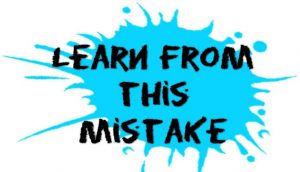What you can learn from my (first) startup failure…
 In 1995, I had an idea. Internet Telephony had just started. Internet connection was available only through dial-up modems, and not all the time. Voice quality was choppy, delayed, and calls were dropped often. Very few people knew how to use it, and you had to sit by the computer to place those calls using a microphone and speakers. You were more likely to call someone who happened to be online than someone you wanted to call. But at the time when international calls had cost more than $4 per minute (Israel to US), the ability to replace those with local calls to my Internet provider was enticing.
In 1995, I had an idea. Internet Telephony had just started. Internet connection was available only through dial-up modems, and not all the time. Voice quality was choppy, delayed, and calls were dropped often. Very few people knew how to use it, and you had to sit by the computer to place those calls using a microphone and speakers. You were more likely to call someone who happened to be online than someone you wanted to call. But at the time when international calls had cost more than $4 per minute (Israel to US), the ability to replace those with local calls to my Internet provider was enticing.
So I started a company (Solram Electronics), and developed a device (InterHome) that connected a computer to the home phones, allowing users to establish an international call at the price of a local call. I filed a patent, which was granted in 1996. In 1997 a prototype was working, and I raised an angel investment round, as well as a government grant. We sold a few hundred units, but sales dried up, and it was impossible to raise another investment, so in 1998 I closed the company.
Looking back, the mistakes I made fell into two categories: product and funding. Learn from my mistakes. It’s a lot cheaper than learning from your own.
1. Consider the entire user experience
The product was simple to use. However, the quality of the call was poor, because Internet connectivity was not very supportive of real-time voice communications at the time. Furthermore, while using the product was relatively easy, installing it was not. Both the electrical connections and the PC software configuration had to be done by a technical person. That, by itself, defeated the purpose of the product, which was to simplify the operation and make it more intentional.
What did I learn? You have to really understand the entire user experience around your new product or service and make sure you do have a superior offering throughout the entire user experience.
2. Raise money when you can, not when you have to
There is always the balance between raising funds too early at a lower evaluation, and raising funds late and risk running out of money. Certain milestones will increase your company’s valuation. AÂ working prototype, a trial, a paying customer, etc. Instead of giving 20% of your company for a $250,000 investment, you might only need to give 10%, or less, if you achieved an important milestone. However, at the same time, if you wait too long, you risk running out of money. I met the founders of a company who waited almost until the last moment to meet with their investors. The meeting was planned for 9/12/2001 in New York.
If you can raise money–do it. Raise more than you need. You are better off with a smaller equity position in your viable company than with a larger equity position in a bankrupt company.
3. Don’t give away equity too soon
When I started the company, I couldn’t afford to pay all key employees, so I ended up giving straight equity (as opposed to an earnout schedule). Too much, and too soon. One of the partners, holding 10% of the equity in the company at that time, just didn’t work out. I had to let him go, and I had to buy his shares back from him.
Instead, let all founders (and employees) earn their equity over time. If you have to let someone go, they will not hold a significant equity position in the company.
4. Grants may have strings attached
Right before raising an investment round, I found that the investors were making their investment through an off-shore account, to avoid taxation. This shouldn’t have been a show-stopper for me, until I realized that one of the government grants I received specifically prevented transfer of ownership outside the country. I had to negotiate the grant all over again.
When taking a grant, make sure you read the fine print, and think about possible future scenarios that might interfere with meeting the commitments you made when you took the grant.
5. Spend money only on development
When a sizable investment comes in, it is tempting to get nicer offices, and all kinds of non-revenue-generating activities. Save the money. Remember that development takes twice as long, and twice as much funding than what you originally thought. Spent every possible dollar on getting the product (or service) ready for early adopters, and later to major market launch.
Once the company is greatly successful, you will always have the opportunity to get those nice offices. Probably even nicer than you can afford now.
6. You can be too far ahead of your time
My idea was a good one. The evidence is that telephone calls today are using packet switching rather than circuit switching. Companies such as Vonage and Skype proved it. But it was too far ahead of its time in 1995. The infrastructure and the technology couldn’t support the application. It took quite a few more years before VoIP caught on.
Being early is generally good. But being too far ahead of time means that the market will not develop fast enough to generate the desired revenue, and you give potential competitors ideas. Timing is everything. Time your products right.
7. Sell all the time
You should never stop selling. It doesn’t matter if you are at a prototype stage, you have a production-ready product, or even only an idea. Selling is a prime opportunity to get feedback on your new offering. As Peter Drucker said, “Business has two–and only two–basic functions: marketing and innovation.” If you have innovation (or development) covered–it’s time to shift your focus to sales. I spent a lot of my time in development, instead of in selling.
The problems that plagued InterHome eventually brought the company to closure in 1998. But I don’t regret starting it, and would do it again in a heartbeat. I learned from that failure, which helped some of my follow-on successes. In 2000, only two years later, I sold another company in Silicon Valley for $22 million.
image credit:Â linkedin.com

Wait! Before you go…
Choose how you want the latest innovation content delivered to you:
- Daily — RSS Feed — Email — Twitter — Facebook — Linkedin Today
- Weekly — Email Newsletter —
 Dr. Yoram Solomon is an inventor, creativity researcher, coach, consultant, and trainer to large companies and employees. His Ph.D. examines why people are more creative in startup companies than in mature ones. Yoram was a professor of Technology and Industry Forecasting at the Institute for Innovation and Entrepreneurship, UT Dallas School of Management; is active in regional innovation and tech transfer; and is a speaker and author on predicting technology future and identifying opportunities for market disruption. Follow @yoram
Dr. Yoram Solomon is an inventor, creativity researcher, coach, consultant, and trainer to large companies and employees. His Ph.D. examines why people are more creative in startup companies than in mature ones. Yoram was a professor of Technology and Industry Forecasting at the Institute for Innovation and Entrepreneurship, UT Dallas School of Management; is active in regional innovation and tech transfer; and is a speaker and author on predicting technology future and identifying opportunities for market disruption. Follow @yoram
NEVER MISS ANOTHER NEWSLETTER!
LATEST BLOGS
How Brexit Has Affected UK E-commerce Businesses
Photo by Zyro on Unsplash The popularity of online shopping was already growing at an impressive rate – and…
Read MoreOvercoming range anxiety: three tips for EV owners
Photo by Jenny Ueberberg on Unsplash In the last few years, electric vehicles (EVs) have become more and more…
Read More

